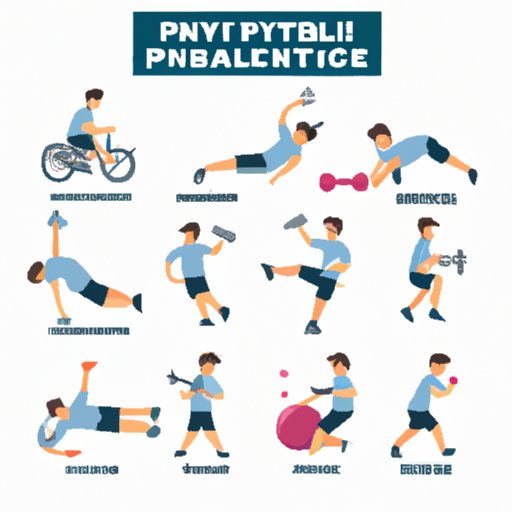
Introduction
Physical inactivity is a growing problem among adults that can lead to a range of health problems, including obesity, heart disease, and diabetes. The good news is that regular physical activity can help prevent and even reverse these conditions. In this article, we will explore the benefits of physical activity for adults, the recommended amount of exercise, and tips for staying motivated to incorporate exercise into our daily routines.
Benefits of Physical Activity for Adults
Physical activity offers a range of benefits for adults, including improved physical, mental, and emotional health. Regular physical activity can help maintain a healthy weight, reduce the risk of chronic diseases, improve cognitive function, and boost mood. According to the Centers for Disease Control and Prevention (CDC), adults should aim for at least 150 minutes of moderate-intensity aerobic activity or 75 minutes of vigorous-intensity aerobic activity each week, along with muscle-strengthening activities on two or more days per week.
Examples of activities that can offer these benefits include brisk walking, cycling, swimming, dancing, and gardening.
The Role of Physical Activity in Weight Management
Physical activity plays a critical role in weight loss and weight maintenance. It helps burn calories and boosts metabolism, making it easier to maintain a healthy weight. The CDC recommends at least 150-300 minutes of moderate-intensity aerobic activity or 75-150 minutes of vigorous-intensity aerobic activity per week for weight management.
Examples of activities that can help achieve weight management goals include running, cycling, swimming, strength training, and yoga.
How to Motivate Yourself to Exercise
Staying motivated to engage in physical activity can be challenging, especially if you’re new to exercise or have a busy schedule. However, there are several strategies you can use to stay motivated and overcome common barriers to physical activity. These include setting realistic goals, finding a workout buddy, joining a fitness class or group, tracking your progress, and rewarding yourself for meeting your goals.
Social support and accountability can also be powerful motivators. Examples of strategies for staying motivated to exercise include working out with a friend, joining a fitness group, or tracking your progress with an app or fitness tracker.
Types of Physical Activity
There are three main types of physical activity: aerobics, resistance training, and flexibility exercises. Each type has its own benefits and is important for maintaining optimal health. The CDC recommends 150-300 minutes of moderate-intensity or 75-150 minutes of vigorous-intensity aerobic activity per week, along with muscle-strengthening activities on two or more days per week, and flexibility exercises on a regular basis.
Examples of aerobic activities include brisk walking, running, cycling, swimming, and dancing. Examples of resistance training activities include weightlifting, resistance band training, and bodyweight exercises like push-ups and squats. Examples of flexibility exercises include stretching, yoga, and Pilates.
The Link Between Physical Activity and Chronic Disease Prevention
Regular physical activity can help prevent chronic diseases such as diabetes, heart disease, and certain types of cancer. The CDC recommends at least 150 minutes of moderate-intensity aerobic activity or 75 minutes of vigorous-intensity aerobic activity per week for reducing the risk of chronic diseases.
Examples of activities that can be particularly beneficial for disease prevention include brisk walking, cycling, swimming, and dancing.
Strategies for Incorporating Physical Activity Into Your Daily Routine
Incorporating physical activity into your daily routine doesn’t have to be complicated or time-consuming. Small changes can add up to significant amounts of physical activity over time. Some examples of easy ways to incorporate physical activity into your day include taking the stairs instead of the elevator, parking farther away from your destination, taking a walk during lunch break, and doing bodyweight exercises during commercial breaks while watching TV.
It’s also important to find activities that are enjoyable and sustainable. For example, if you love dancing, consider taking a dance class or joining a dance group. If you enjoy being outdoors, try hiking or gardening.
Conclusion
In conclusion, regular physical activity offers a range of benefits for adults, including improved physical, mental, and emotional health. To experience these benefits, adults should aim for at least 150 minutes of moderate-intensity aerobic activity or 75 minutes of vigorous-intensity aerobic activity each week, along with muscle-strengthening activities on two or more days per week. Staying motivated to exercise can be challenging, but finding strategies that work for you, such as exercising with a friend or tracking your progress, can help. Finally, it’s important to find activities that are enjoyable and sustainable, so you can make physical activity a regular part of your daily routine.





